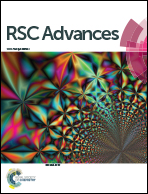Analysis of chondroitin sulfate from different sources of cartilage by electrophoretically mediated microanalysis†
Abstract
An electrophoretically mediated microanalysis (EMMA) protocol for the determination of different chondroitin sulfate (CS) origins based on the difference in the content of unsaturated disaccharides produced by degradation with chondroitinase ABC was developed. Separations were performed in an uncoated fused silica capillary (total length: 60.2 cm, effective length: 50 cm, 50 μm i.d.) at 20 kV and 37 °C. The influences of various parameters, such as different kinds of separation buffers, substrate concentration and incubation time, on separation were investigated. The optimum conditions were as follows: separation buffer, 25 mM tetraborate buffer (pH 9.5); incubation buffer, 50 mM Tris-60 mM acetate buffer (pH 8.0); sample injection, 5 s at 0.5 psi; CS concentration, 500 μg mL−1; incubation time, 8 min. Nonsulfated, monosulfated, disulfated and trisulfated Δ-disaccharides were separated well under the above optimal conditions. The developed method was used to determine the amounts of disaccharides in CS from different sources and the results were compared with those obtained by offline analysis. The results indicated that the developed method could successfully distinguish CS with minor differences and could obtain good coherence results compared with the traditional method.


 Please wait while we load your content...
Please wait while we load your content...